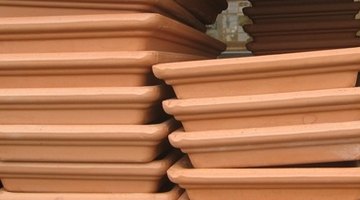How to Best Apply Linseed Oil to Terracotta Tiles
Terracotta ("baked earth") tiles are a flooring material made out of clay hardened in ovens. They generally have a rusty-red color and are commonly used to give a rustic touch to a room. Since they are made of natural clay, terracotta tiles are extremely porous; a coat of sealant is necessary to ensure durability and easy cleaning. Although artificial chemical sealants do exist, the most common sealant for terracotta tiles is boiled linseed oil.

-
Clean the tiles very thoroughly once they've been glued down. You should remove any dirt, dust and spilled tile adhesive. It is best to use just water and a cloth to clean unsealed tiles, although you can also add a bit of vinegar and baking soda to the water to make it a more potent cleanser in case of hardened dirt.
-
Spread an even coat of boiled linseed oil across the tiles; this works best with a short-haired paint roller or a paintbrush. You do not need to boil the linseed oil yourself. It will be sold in packages labeled "boiled" at any home improvement store. Check carefully that this label is there---unboiled linseed oil will take much longer to dry.
-
Watch the just-oiled tiles to see how long it takes for the oil to soak in, leaving them with a matte finish again. A good coat should take from 2 to 10 minutes; if the oil disappears faster than that you will need to add more.
-
Dry the linseed oil by letting the tiles sit for 24 hours.
-
Apply another, thinner coat of linseed oil after you have grouted the gaps between the tiles and cleaned the excess grout from their surfaces with a wet sponge.
-
Wipe off any oil that hasn't soaked into the tiles after 20 minutes.
-
Apply a coat of floor wax once the oil has soaked in. This will protect the finish.
Writer Bio
Joshua Smyth started writing in 2003 and is based in St. John's, Newfoundland. He has written for the award-winning "Cord Weekly" and for "Blueprint Magazine" in Waterloo, Ontario, where he spent a year as editor-in-chief. He holds a Bachelor of Arts in political science and economics from Wilfrid Laurier University.
Photo Credits
- terracotta image by knirzporz from Fotolia.com
More Articles



